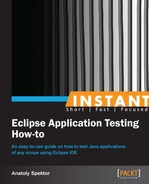Eclipse Application Testing How-to is a hands-on guide to Eclipse application testing. After reading it you will be able to effectively debug Java applications of any scope. Fortunately, this book does not require any prior knowledge of Eclipse; thus it is suitable for developers with any level of experience in Eclipse application development and testing. Following is the outline of what you will learn after reading this book.
Setting up the work environment (Simple) will get you started. You will learn how to install Java and Eclipse and start coding our sample project, which you will be using for debugging throughout the book. Moreover, this recipe will give you a table of Eclipse shortcuts so that you could effectively navigate through the Eclipse environment.
Exploring Eclipse Debug Perspective (Simple) will let you know what every element of Eclipse Debug Perspective stands for.
Using Debug Perspective – setting breakpoints (Simple) will explain to you what breakpoint is and how to use it, breakpoint being the main debugging tool.
Using a conditional breakpoint (Medium) will help you to debug complex applications after learning about the conditional breakpoints in this recipe. Of course, you will have a chance to try this breakpoint type yourself on our sample project.
Using an exception breakpoint (Medium) will be of great help while debugging. You will learn this breakpoint type in this recipe.
Using a method breakpoint (Medium) will help you learn about a method breakpoint. Dealing with large methods, and also your concern about what values to enter in the method and what values exit the method, is reduced with this breakpoint type.
Using Watchpoint (Medium) talks about the use of a Watchpoint. Watchpoint is a very useful tool that is used to track the access and/or modification of the variables.
Using Printpoint (Medium) will help you learn how to use Printpoint. Many IDEs use the Printpoint tool to output the value of a variable to the console.
Using a hit count breakpoint (Medium) will help you understand the breakpoints in depth. You will learn what a hit count breakpoint is. This tool will save you a lot of time when debugging large-scale projects and loops, thus making you more productive.
JUnit testing (Simple) will give you an insight into the Java testing framework called JUnit. You will find out how to set it up, and why it is one of the most used tools in Java application testing.
Coding JUnit tests (Simple) will help you learn about JUnit testing. You will code your own JUnit test case for our sample program. Moreover, you will run your test and learn how to analyze the results.
Creating a JUnit Test Suite (Medium) will show you how to combine your JUnit tests in one suite and how to run all your tests at once.
